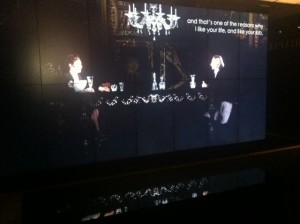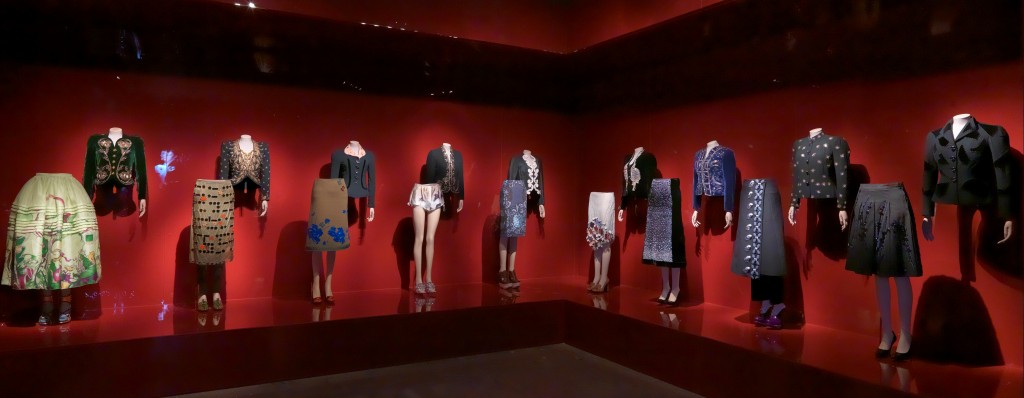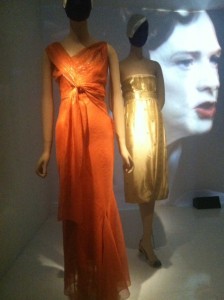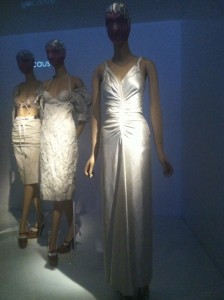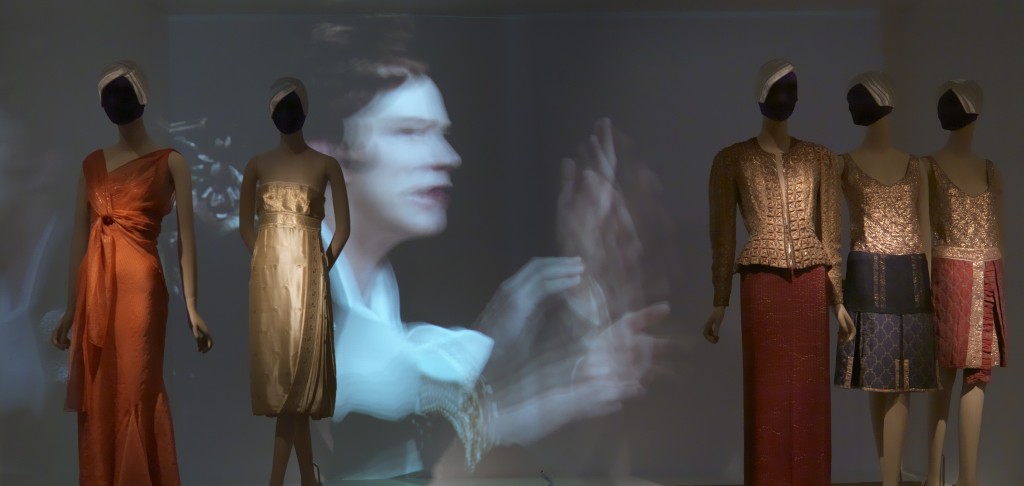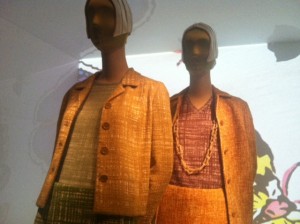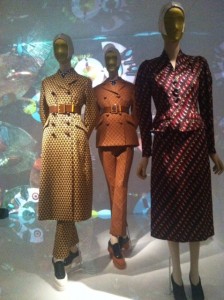The first thing you see when you enter the Metropolitan Museum’s exhibit “Schiaparelli and Prada: Impossible Conversations” is a large screen. On it, a scene with a dinner table and a crystal chandelier against a black backdrop. There are two women sitting at opposite each other, engaging in conversation. Miuccia Prada is played by herself, and Elsa Schiaparelli, who died in 1973, is played brilliantly by Judy Davis. Schiap’s words are taken from her autobiography Shocking Life. This first film clip sets the scene; the two designers talk about how it was not their plan to be a fashion designer.
As you work your way through the “Impossible Conversations” exhibit, now open through August 19, 2012, you can’t help but thinking lucky for us they became not just designers but iconic figures in the fashion world. It seems hard to believe that Prada was, as she says, never influenced by Schiaparelli. In the “Waist Up / Waist Down” section, the ornate Schiap jackets pair so well with the embellished Prada skirts that you have a hard time believing that they were made some 60 to 70 years apart. They seem to be cut so to speak, from the same cloth. And so it goes throughout the exhibit.
These two designers are both Italian, but generations apart, with Schiaparelli working in the 1930’s to 1950’s and Prada designing today. They are very much alike but also very different. The exhibit beautifully plays up these similarities and contrasts, in both the clothing on the mannequins and in the imagined dialogue between the two women. There are seven film clips, each serving as a backdrop to different scenes in the exhibit.
In Schiaparelli’s day, ornamental hats were the big thing. She’s famous for her shoe hat, a result of a collaboration with the Spanish artist Salvador Dali. For Prada, ornamental shoes are her thing, and her latest collection is of shoes inspired by vintage cars. Vintage Cadillacs with tail fins are re-imagined as shoes, complete with tail lights.
A sense of whimsy and art are recurring motifs in the two designers’ collections. Yet in their impossible conversation the women disagree on calling fashion designers artists. Prada dismisses that label; Schiap embraces it.
So it may be no surprise then that Prada was reportedly reluctant to participate in this project, a collaboration of the Met’s Costume Institute curators Harold Koda and Andrew Bolton with renown film director Baz Luhrmann. She wasn’t too keen on being compared to another designer. But she told reporters that now she likes the exhibit. She posed for a photo op with Vogue editor-in-chief Anna Wintour at the press preview on Monday. Apparently there was doubt about whether or not Prada would show up for that night’s Costume Institute gala, because she fell off her high platform shoes, but she was there.
Throughout the seven film clips in the galleries, Schiap and Prada rarely agree. Schiap says she designed the fabulous and sometimes playful hats, necklaces and jackets to celebrate a woman’s beauty. In her cafe society, women were seated and the lower half of the body was not seen. Prada abhors frilliness and decorations near the face.
The two women talk about how they try to avoid clichés of women and conventional beauty. Schiap says her mother called her ugly; Prada fights beauty. Some of Prada’s designs can be downright dowdy. But Prada does manage to create something beautiful out of mismatched prints and fabrics, as seen in the “Ugly Chic” section of the exhibit. Prada says if she’s done anything, “It is to make ugly appealing.” Agreed.
You can’t help but notice that Prada is much more reserved, even to the point of being depressing, compared to Schiaparelli. Prada says it’s impossible to shock the fashion world, as Schiap was able to do. She can’t do evening gowns.
Schiap and Prada never come to any resound conclusion to their conversation at the end of the exhibit. Schiap tries to get Prada to agree that fashion design is art. “Never Schiap, Never.”
At the end, it’s not hard to imagine that Schiap and Prada would have a conversation and lively debate were they living at the same time. And they do agree in the last film clip that they’d probably be friends. You come away from the exhibit with the feeling that both women are extremely strong personalities who celebrate women through design in similar ways. And I can’t help but wonder who might be in an impossible conversation with Prada in the latter part of the 21st century.

